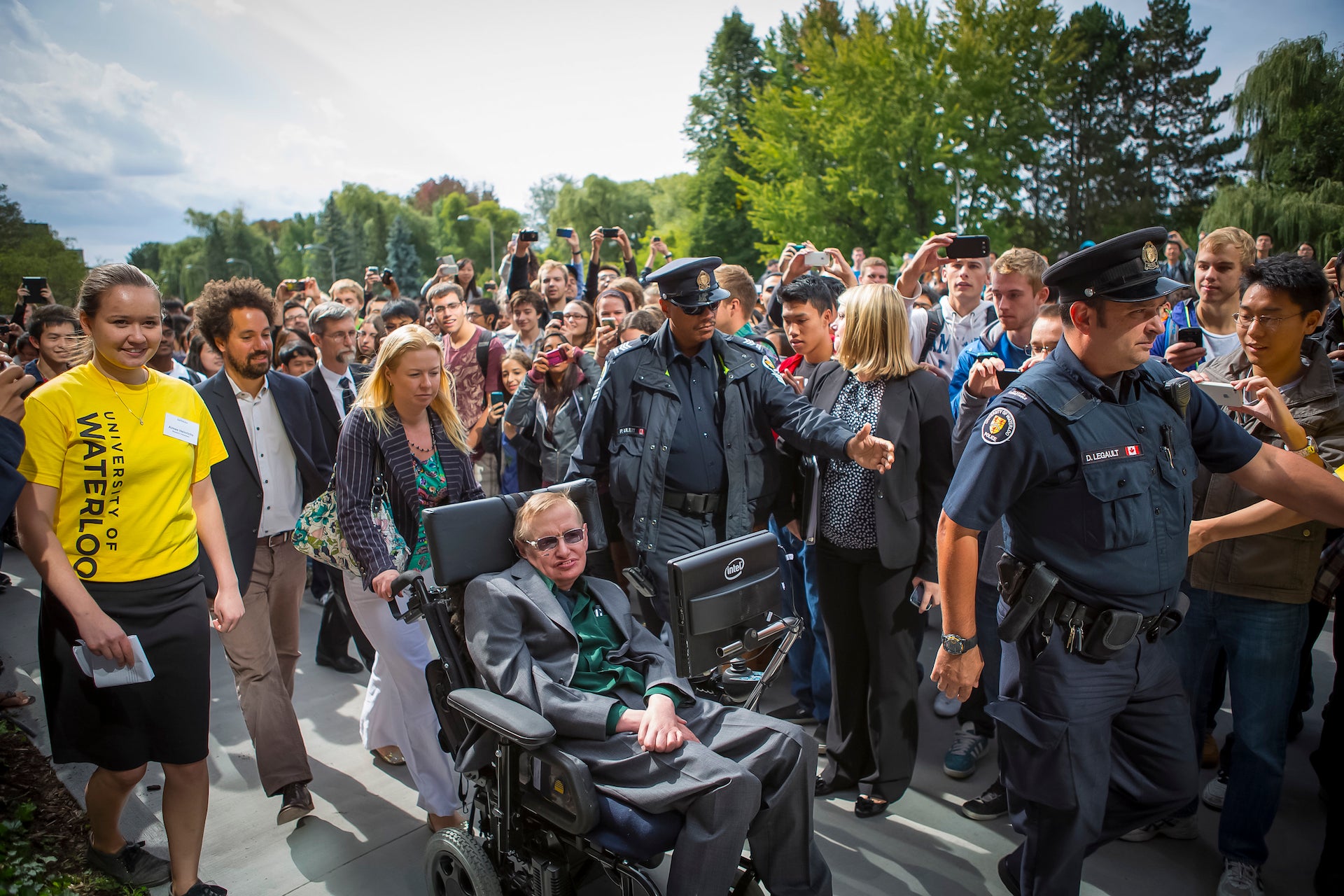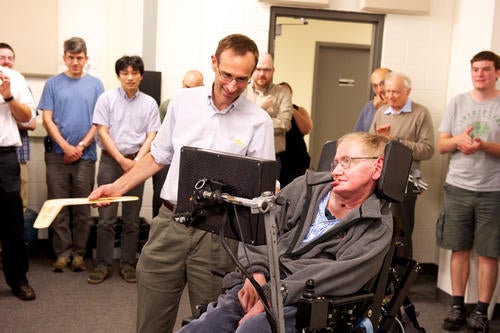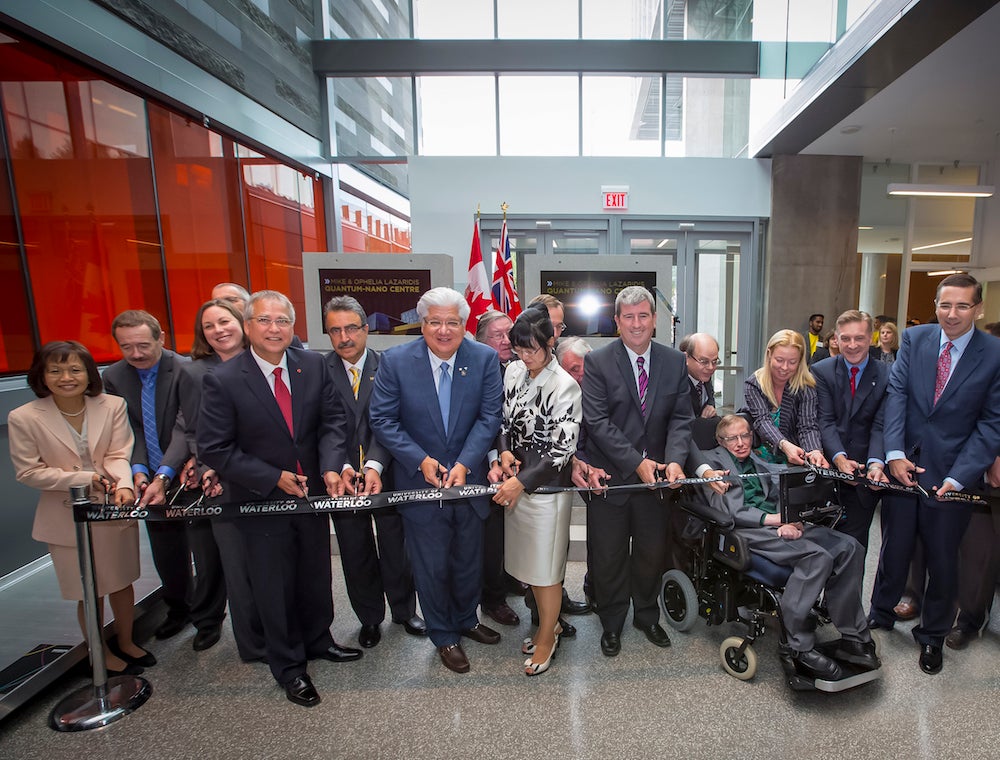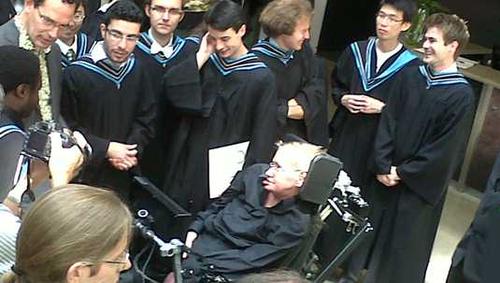
Waterloo remembers Stephen Hawking
World renowned theoretical physicist dies at the age of 76.

World renowned theoretical physicist dies at the age of 76.
By University RelationsThe scientific community, and the world, is deeply saddened by the news of Professor Stephen Hawking’s death.
Hawking had strong ties to the University of Waterloo and last visited campus in 2012. His appearance as the ribbon cutter and guest speaker at the grand opening of the Mike and Ophelia Lazaridis Quantum-Nano Centre in 2012 resulted in a rock-star welcome by thousands of excited fans. Following the event, the world-renowned scientist took time to meet the considerable crowd that had amassed outside the front entrance of the centre.

"I am getting to know Waterloo well and it is clear to me that this place is special," said Professor Hawking in his remarks to the audience that day. "It is special for many reasons, including its collaborative culture; its research excellence; its philanthropic visionaries; and its leadership in post-secondary education."
In 2008, Hawking was named a Distinguished Research Chair by the Perimeter Institute for Theoretical Physics, an honour that had the famous scientist visiting Waterloo Region and the University of Waterloo campus on a regular basis. In 2008 and 2010, Hawking visited the Perimeter Institute and the Institute for Quantum Computing (IQC), where he reunited with Founding Executive Director for IQC Raymond Laflamme, who had been Hawking’s PhD student at the University of Cambridge.
“In the 1980s, when Professor Hawking was writing his best-selling book A Brief History of Time, it was my job to mathematically demonstrate his theory about what happens to time in a contracting universe,” said Laflamme. “Instead, I found that the math just didn’t add up, meaning that Hawking’s suggestion – that time reverses direction – could not be true. Afterwards, he gave me a copy of his book with a personalized inscription: ‘To Raymond, who showed me that the arrow of time is not a boomerang. Thank you for all your help. Stephen’.”

It was only fitting then that Laflamme’s gift to Hawking on his final visit to Waterloo was a wooden boomerang.
“He immediately understood its significance. The boomerang was a fun inside joke, but it was more than that. It was a way of saying that, although time is indeed an arrow, it has a way of bringing our lives – and what is most important to us – full circle.”

Professor Hawking was monumental in shaping the world’s understanding of modern physics and was known for his theories on black holes and relativity, and made significant contributions to cosmology and quantum gravity. He was also committed to communicating his findings to a broad audience.
“The recipe is simple: Bring brilliant people together, in an inspiring and free intellectual environment, where they are encouraged to pursue ambitious and timely research,” said Hawking during his 2010 visit. “The importance of special places and special times, where magical progress can happen, cannot be overstated. It seems to me, the same ingredients are being assembled here. I am hoping, and expecting, great things will happen here.”

The University thanks Professor Hawking for his impactful contributions to theoretical physics. He was an incredible scientist who has changed the way we think about the universe. His work will continue to inspire scientists all over the world, and generations for years to come.
Hawking died on Wednesday, March 14, a date that also happened to be Albert Einstein’s birth anniversary as well as Pi Day, at the age of 76.

Read more
New tool estimates real-world costs of quantum computing so businesses can become quantum ready

Read more
The awarded proposal seeks to understand and mitigate the loss of quantum information

Read more
Scientists recreate properties of light in neutral fundamental particles called neutrons
The University of Waterloo acknowledges that much of our work takes place on the traditional territory of the Neutral, Anishinaabeg, and Haudenosaunee peoples. Our main campus is situated on the Haldimand Tract, the land granted to the Six Nations that includes six miles on each side of the Grand River. Our active work toward reconciliation takes place across our campuses through research, learning, teaching, and community building, and is co-ordinated within the Office of Indigenous Relations.